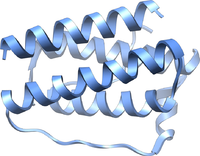
Photo from wikipedia
This study aimed to identify the parameters related to the area and adipose tissue content of thigh muscles that are associated with radiographic knee osteoarthritis grade. Fifty patients (mean age ± standard… Click to show full abstract
This study aimed to identify the parameters related to the area and adipose tissue content of thigh muscles that are associated with radiographic knee osteoarthritis grade. Fifty patients (mean age ± standard deviation, 73.0 ± 4.5 years) were divided into early osteoarthritis (n = 23) and established osteoarthritis (n = 27) groups based on Kellgren–Lawrence classification. The femorotibial angle was measured from anteroposterior radiographs of the lower limbs. Individual thigh muscle and adipose tissue areas were analyzed using axial T1-weighted magnetic resonance imaging. After intergroup comparison, logistic regression analysis was performed to determine independent parameters associated with established osteoarthritis. Moreover, correlation coefficients were assessed between the left–right differences of osteoarthritis grade and parameters. Established osteoarthritis exhibited a significantly greater femorotibial angle and increased adipose tissue content in the subcutaneous, intermuscle, and intramuscle of the adductor, vastus lateralis, vastus intermedius, as well as a lower vastus medialis area, in comparison to early osteoarthritis. A greater femorotibial angle, increased intermuscular adipose tissue, and a lower vastus medialis area to knee extensor ratio were significantly independently associated with established osteoarthritis (odds ratio 3.2, 1.8, and 2.0, respectively). The left–right differences of femorotibial angle and vastus medialis area were significantly correlated with osteoarthritis grade, whereas adipose tissue content had no significant correlations with osteoarthritis grade. Greater femorotibial angle and lower vastus medialis area were related with higher osteoarthritis grade. Greater intermuscular adipose tissue content was associated with established osteoarthritis; however, in the left–right differences, adipose tissue content was not related with osteoarthritis grade.
Journal Title: Rheumatology International
Year Published: 2019
Link to full text (if available)
Share on Social Media: Sign Up to like & get
recommendations!